Application of Geophysical Methods in the Identification of Mineralized Structures and Ranking of Areas for Drilling as Exemplified by Alto Guaporé Orogenic Gold Province
Abstract
1. Introduction
2. Geological Context
2.1. Geological Settings
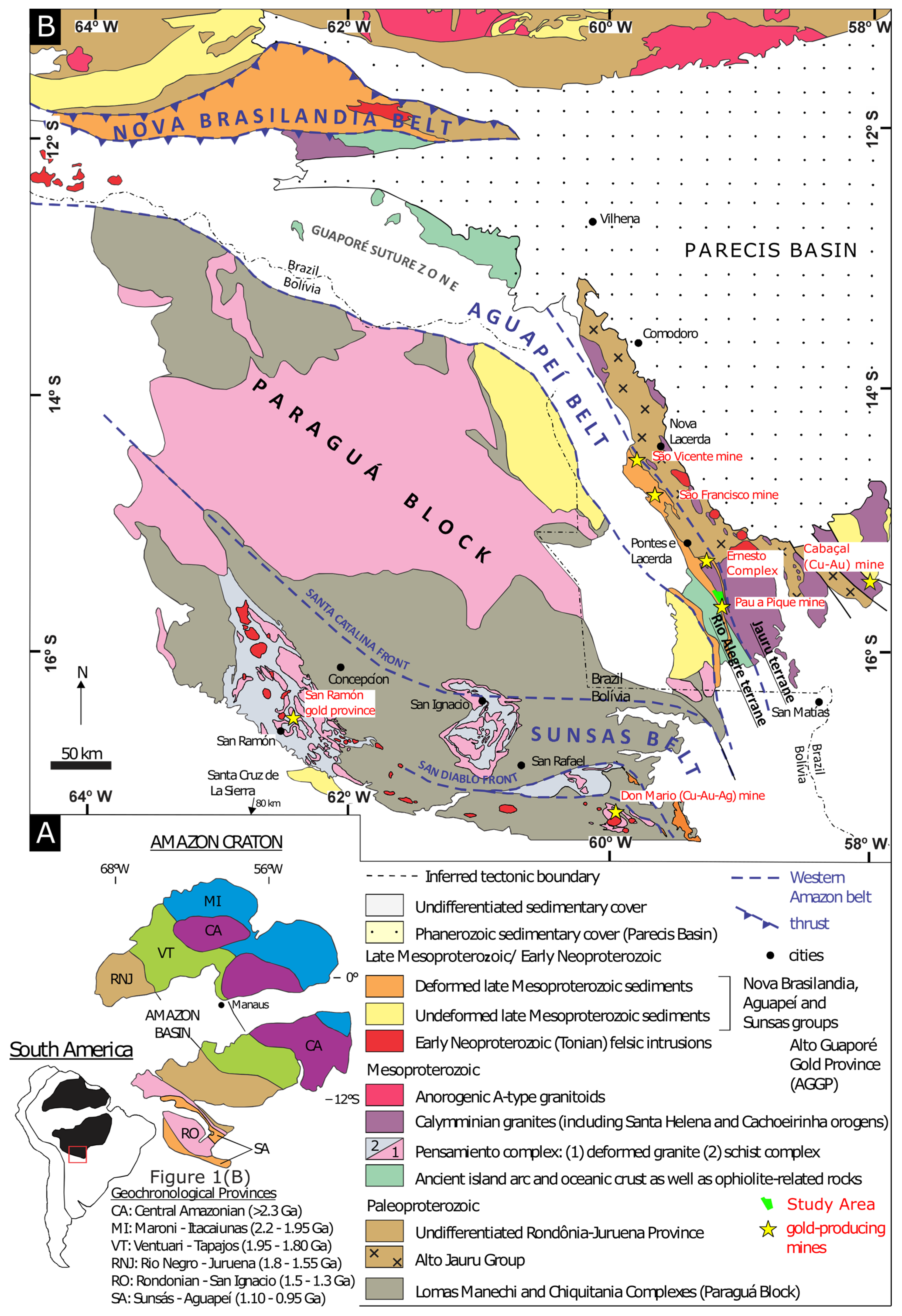
2.2. ABP Target
3. Methods
3.1. Ground Magnetic Survey
3.2. Induced Polarization Survey
4. Results
4.1. Ground Magnetic Data
4.2. Geoelectrical Survey
4.2.1. Resistivity
4.2.2. Chargeability
5. Discussion
5.1. Prospective Geological-Geophysical Model for Gold Deposits in the Alto Guaporé Gold Province
5.2. 3D Geological Features
6. Conclusions
Author Contributions
Funding
Data Availability Statement
Acknowledgments
Conflicts of Interest
References
- Groves, D.I.; Santosh, M. Province-scale commonalities of some world-class gold deposits: Implications for mineral exploration. Geosci. Front. 2015, 6, 389–399. [Google Scholar] [CrossRef]
- Groves, D.I.; Santosh, M.; Zhang, L. A scale-integrated exploration model for orogenic gold deposits based on a mineral system approach. Geosci. Front. 2020, 11, 719–738. [Google Scholar] [CrossRef]
- Roshanravan, B.; Kreuzer, O.P.; Buckingham, A.; Keykhay-Hosseinpoor, M.; Keys, E. Mineral potential modelling of orogenic gold systems in the granites-tanami Orogen, Northern Territory, Australia: A multi-technique approach. Ore Geol. Rev. 2023, 152, 105224. [Google Scholar] [CrossRef]
- Costa Neto, M.C. Estudo Da Interação Fluido-Rocha Nos Depósitos Da Lavrinha, Distrito Aurífero de Pontes E Lacerda-MT. Master’s Thesis, Universidade de Campinas (UNICAMP), Campinas, Brazil, 1998. [Google Scholar]
- Fernandes, C.J.; Kuyumjian, R.M.; Moura, M.A.; Barboza, E.d.S.; Pulz, M.G. Tipologia dos veios de quartzo e estudo de inclusões fluidas nos depósitos de ouro da Faixa Móvel Aguapeí–Cráton Amazonico–Mina de São Vicente, Região da Lavrinha e Pau-a-Pique. Rev. Bras. Geociências 2006, 36 (Suppl. S1), 59–70. [Google Scholar]
- Fernandes, C.J.; Kuyumjian, R.M.; Pulz, G.M.; Geraldes, M.C.; Pinho, F.E.C. Geologia Estrutural e Idade 40Ar/39Ar do depósito Pau a Pique, Faixa Móvel Aguapeí, Sudoeste do estado de Mato Grosso. Rev. Bras. Geociências 2006, 36 (Suppl. S1), 13. [Google Scholar]
- Fernandes, C.J.; Pulz, G.M.; Kuyumjian, R.M.; Pinho, F.E.C. Diferenças Entre os Depósitos Auríferos do Grupo Aguapeí (Estado de Mato Grosso) e os Clássicos Exemplos de Ouro em Conglomerados. Pesqui. Em Geociências-UFRGS 2005, 32, 10. [Google Scholar] [CrossRef]
- Fernandes, C.J.; Ruiz, A.S.; Kuyumjian, R.M.; Pinho, F.E. Geologia e Controle Estrutural dos Depósitos de Ouro do Grupo Aguapeí-Região da Lavrinha, Sudoeste do Craton Amazônico. Rev. Bras. Geociências 2005, 35, 13–22. [Google Scholar] [CrossRef][Green Version]
- Melo, R.P.d.; Oliveira, M.A.F.d.; Goldfarb, R.J.; Johnson, C.A.; Marsh, E.E.; Xavier, R.P.; de Oliveira, L.R.; Morgan, L.E. Early Neoproterozoic Gold Deposits of the Alto Guaporé Province, Southwestern Amazon Craton, Western Brazil. Econ. Geol. 2022, 117, 127–163. [Google Scholar] [CrossRef]
- Scabora, J.A.; Duarte, C.L. A Jazida de Ouro de São Vicente–Município de Nova Lacerda–MT. A Terra Em Rev. 1998, 4, 32–42. [Google Scholar]
- Don Mario Reserves/Resources. 2020. Available online: https://www.orvana.com/English/operations/don-mario-district/reserves-resources/default.aspx (accessed on 7 June 2023).
- Pinho, F.E.C. The Origin of the Cabacal Cu-Au Deposit, Alto Jauru Greenstone Belt, Brazil. Ph.D. Thesis, The University of Western Ontario, London, ON, Canada, 1996. [Google Scholar]
- Pinho, F.E.C.; Fyfe, W.S. Isotopic Studies of the Carbonate Veins of the Cabaçal Mine, Mato Grosso, Brazil. Rev. Bras. De Geociências 1999, 29, 327–330. [Google Scholar] [CrossRef]
- Litherland, M.; Annells, R.N.; Darbyshire, D.P.F.; Fletcher, C.J.N.; Hawkins, M.P.; Klinck, B.A.; Mitchell, W.I.; Oconnor, E.A.; Pitfield, P.E.J.; Power, G.; et al. The proterozoic of eastern Bolivia and its relationship to the Andean mobile belt. Precambrian Res. 1989, 43, 157–174. [Google Scholar] [CrossRef]
- Litherland, M.; Bloomfield, K. The Proterozoic History of eastern Bolivia. Precambrian Res. 1981, 15, 157–179. [Google Scholar] [CrossRef]
- Ruiz, A.S.; Simões, L.S.A.; Araujo, L.M.B.d.; Matos, J.B.d.; Souza, M.Z.A. Cinturão Orogênico Aguapeí (1025-900Ma): Um exemplo de Faixa Móvel Intracontinental no SW do Cráton Amazônico. An. Do XI Simp. Nac. De Estud. Tectonicos 2007, 116–118. [Google Scholar]
- Teixeira, W.; Geraldes, M.C.; Matos, R.; Ruiz, A.S.; Saes, G.; Vargas-Mattos, G. A review of the tectonic evolution of the Sunsás belt, SW Amazonian Craton. J. S. Am. Earth Sci. 2010, 29, 47–60. [Google Scholar] [CrossRef]
- Melo, R.P.d. Caracterização do metamorfismo da Faixa Móvel Aguapeí e sua relação com a gênese dos depósitos de ouro da região de Pontes e Lacerda-MT. Ph.D. Thesis, Universidade Estadual Paulista, Rio Claro, Brazil, 2016. [Google Scholar]
- D’Agrella-Filho, M.S.; Tohver, E.; Santos, J.O.S.; Elming, S.A.; Trindade, R.I.F.; Pacca, I.I.G.; Geraldes, M.C. Direct dating of paleomagnetic results from Precambrian sediments in the Amazon craton: Evidence for Grenvillian emplacement of exotic crust in SE Appalachians of North America. Earth Planet. Sci. Lett. 2008, 267, 188–199. [Google Scholar] [CrossRef]
- Geraldes, M.C.; Nogueira, C.; Vargas-Mattos, G.; Matos, R.; Teixeira, W.; Valencia, V.; Ruiz, J. U–Pb detrital zircon ages from the Aguapeí Group (Brazil): Implications for the geological evolution of the SW border of the Amazonian Craton. Precambrian Res. 2014, 244, 306–316. [Google Scholar] [CrossRef]
- Leite, J.A.D.; Saes, G.S. Geology of the southern Amazon craton in southwestern Mato Grosso, Brazil: A review. Rev. Bras. De Geociências 2000, 30, 91–94. [Google Scholar] [CrossRef]
- Saes, G.S. Evolução Tectônica E Paleogeográfica Do Aulacógeno Aguapeí (1.2–1.0 GA) E Dos Terrenos Do Seu Embasamento NA Porção Sul Do Craton Amazônico. Ph.D. Thesis, Universidade de São Paulo, São Paulo, Brazil, 1999. [Google Scholar]
- Saes, G.S.; Leite, J.A.D. Evolução tectono-sedimentar do Grupo Aguapeí, Proterozoico médio na porção meridional do Cráton Amazônico: Mato Grosso e oriente boliviano. Rev. Bras. De Geociências 1993, 23, 31–37. [Google Scholar] [CrossRef][Green Version]
- Rizzotto, G.J.; Santos, J.O.S.; Hartmann, L.A.; Tohver, E.; Pimentel, M.M.; McNaughton, N.J. The Mesoproterozoic Guaporé suture in the SW Amazonian Craton: Geotectonic implications based on field geology, zircon geochronology and Nd–Sr isotope geochemistry. J. S. Am. Earth Sci. 2013, 48, 271–295. [Google Scholar] [CrossRef]
- Ruiz, A.S. Evolução Geológica do Sudoeste do Cráton Amazônico Região Limítrofe Brasil Bolívia-Mato Grosso; Tese (Doutorado em Geociências)–Instituto de Geociências e Ciências Exatas, Universidade Estadual Paulista: Rio Claro, Brazil, 2005; 289p. [Google Scholar]
- Bettencourt, J.S.; Leite, W.B.; Ruiz, A.S.; Matos, R.; Payolla, B.L.; Tosdal, R.M. The Rondonian-San Ignacio Province in the SW Amazonian Craton: An overview. J. S. Am. Earth Sci. 2010, 29, 28–46. [Google Scholar] [CrossRef]
- Menezes, R.G.; Silva, L.C.; Takahashi, A.T.; Lopes, L., Jr.; Bezerra, J.R.L. Folha Pontes e Lacerda, SD.21-Y-C-II; CPRM: Brasília, Brazil, 1993. [Google Scholar]
- Mitchinson, D.E. Targeting Archean Orogenic Gold Mineralization Using Physical Properties and Integrated Geophysical Methods. Ph.D. Thesis, University of British Columbia, Vancouver, BC, Canada, 2009. [Google Scholar]
- Morais, D.S.F. Estudo da Crosta no Sudoeste do Cráton Amazônico Utilizando Técnicas Sismológicas; Tese (Doutorado em Geociências)–Instituto de Geociências e Ciências Exatas, Universidade Estadual Paulista: Rio Claro, Brazil, 2018; 119p. [Google Scholar]
- Aisengart, T.; Barbosa, D.; Pithawala, T.; Pereira, J.; Porto, C.; Ando, J.L.; Rechand, M.; Johnson, A. High resolution inversion of the magnetization vector in the Pontes e Lacerda area of southwestern Mato Grosso, Brazil. J. Geophys. 2017, 38, 159–164. [Google Scholar]
- MacKenzie, D.; Craw, D. Geophysical Signals and Exploration for Orogenic Gold on the Low-grade Margins of the Otago Schist. In Proceedings of the Gold’17 Conference, Rotorua, New Zealand, 17 August 2017. Extended Abstracts: 62–65. [Google Scholar]
- Niiranen, T.; Nykänen, V.; Lahti, I. Scalability of the Mineral Prospectivity Modelling–An orogenic gold case study from northern Finland. Ore Geol. Rev. 2019, 109, 11–25. [Google Scholar] [CrossRef]
- Song, M.; Xue, G.; Liu, H.; Li, Y.; He, C.; Wang, H.; Wang, B.; Song, Y.; Li, S. A Geological Geophysical Prospecting Model for Deep-Seated Gold Deposits in the Jiaodong Peninsula, China. Minerals 2021, 11, 1393. [Google Scholar] [CrossRef]
- Adetunji, A.Q.; Launay, G.; Ferguson, I.J.; Simmons, J.M.; Ma, C.; Ayer, J.; Lafrance, B. Crustal conductivity footprint of the orogenic gold district in the Red Lake greenstone belt, western Superior craton, Canada. Geology 2023, 51, 377–382. [Google Scholar] [CrossRef]
- Seigel, H.O.; Johnson, I.; Hennessey, J. Different methodology: Geophysical aids to gold exploration. Lead. Edge 1984, 3, 32–35. [Google Scholar] [CrossRef]
- Li, Y.; Oldenburg, D.W. 3D inversion of magnetic data. Geophysics 1996, 61, 32–35. [Google Scholar] [CrossRef]
- Doyle, H.A. Geophysical exploration for gold—A review. Geophysics 1990, 55, 134–146. [Google Scholar] [CrossRef]
- Halloff, P.G.; Yamashita, M. The use of the IP method to locate gold-bearing sulfide mineralization. In Induced Polarization: Applications and Case Histories, Society of Exploration Geophysicists; Fink, J.B., Sternberg, B.K., McAlistar, E.O., Weiduwilt, W.G., Ward, S.H., Eds.; SEG or Society of Exploration Geophysicists: Tulsa, OK, USA, 1990; pp. 227–279. [Google Scholar]
- Ribeiro, V.B.; Mantovani, M.S.M.; Louro, V.H.A. Geophysical study of the Sertãozinho, Rio Aguapeí and Nova anomalies (SW of Mato Grosso, Brasil). In Proceedings of the 13th International Congress of the Brazilian Geophysical Society (SBGf), Rio de Janeiro, Brazil, 26–29 August 2013. [Google Scholar]
- Cole, K.S.; Cole, R.H. Dispersion and absorption in dielectrics. I. alternating current characteristics. J. Chem. Phys. 1941, 9, 341–351. [Google Scholar] [CrossRef]
- Rizzotto, G.J.; Hartmann, L.; Santos, J.O.S.; McNaughton, N. Tectonic evolution of the southern margin of the Amazonian craton in the late Mesoproterozoic based on field relationships and zircon U-Pb geochronology. Ann. Braz. Acad. Sci. 2014, 86, 57–84. [Google Scholar] [CrossRef]
- Cordani, U.G.; Teixeira, W. Proterozoic accretionary belts in the Amazonian Craton. In 4-D Framework of Continental Crust: Geological Society of America Memoir 200; Hatcher, R.D., Jr., Carlson, M.P., McBride, J.H., Martínez Catalán, J.R., Eds.; 2007; pp. 297–320. Available online: https://www.researchgate.net/publication/236016478_Proterozoic_accretionary_belts_in_the_Amazonian_Craton (accessed on 21 January 2024).
- Schobbenhaus, C.; Bellizzia, G. Geologic map of South America. 2001. Available online: http://rigeo.cprm.gov.br/jspui/handle/doc/2542 (accessed on 12 November 2023).
- Tassinari, C.G.; Macambira, M.J.B. Geochronological provinces of the Amazonian Craton. Episodes 1999, 22, 174–182. [Google Scholar] [CrossRef]
- Litherland, M. Mapa Geológico del Área del Proyecto Precámbrico (1976–1983), 1:1,000,000 Map Sheet. Br. Geol. Surv. 1984. Available online: https://colecoes.igc.usp.br/colecao/mapoteca/bolivia-mapa-geologico-del-area-del-proyecto-precambrico-1976-83 (accessed on 12 November 2023).
- Rizzotto, G.J. Petrologia e Geotectônica do Grupo Nova Brasilândia, Rondônia. Master’s Thesis, Federal University of Rio Grande do Sul, Porto Alegre, Brasil, 1999. [Google Scholar]
- Souza, E.P.; Hildred, P.R. Contribuição ao estudo da geologia do Grupo Aguapeí, oeste de Mato Grosso Congresso Brasileiro de Geologia. Camboriú Soc. Bras. De Geol. 1980, 2, 813–825. [Google Scholar]
- Matos, J.B.D.; Schorscher, J.H.D.; Geraldes, M.C.; Souza, M.Z.A.D.; Ruiz, A.S. Petrografia, Geoquímica e Geocronologia das Rochas do Orógeno Rio Alegre, Mato Grosso: Um Registro de Crosta Oceânica Mesoproterozóica no SW do Cráton Amazônico. Rev. Inst. Geociências-USP 2004, 4, 75–90. [Google Scholar] [CrossRef]
- Pulz, G.M.; Barbosa, E.S.; Pinho, F.E.C.; Ronchi, L.H.; Jelinek, A.R.; Duarte, L.d.C. Inclusiones fluidas en venas auríferas del yacimiento Pau-a-Pique, suroeste del craton Amazónico, Brasil. Boletín De La Soc. Española De Mineral. 2003, 26, 79–92. [Google Scholar]
- Geraldes, M.C.; Van Schmus, W.R.; Condie, K.C.; Bell, S.; Teixeira, W.; Babinski, M. Proterozoic geologic evolution of the SW part of the Amazonian craton in Mato Grosso state, Brazil. Precambrian Res. 2001, 111, 91–128. [Google Scholar] [CrossRef]
- Cezar, P.A. Caracterização Deformacional e Metamórfica do Cinturão Móvel Aguapeí nas Serras do Caramujo e Salto do Aguapeí-SW de Mato Grosso; Undergraduate Report; Universidade Estadual Paulista: Rio Claro, Brazil, 2004; 117p. [Google Scholar]
- Fernandes, C.J.; Pulz, G.M.; Oliveira, A.S.; Cunha, M.C.L.; Barbosa, E.S.; Pinho, F.E.; Quadros, A.P. Diferenças químicas e texturais entre os veios de quartzo férteis e estéreis no depósito Pau-a-Pique. Pesqui. Em Geociências 1999, 26, 91–101. [Google Scholar] [CrossRef][Green Version]
- Baia, F.H. Caracterização Litológica e Estrutural da Área “Cava Principal”, Alvo Aurífero Pau-a-Pique, na Faixa Aguapeí, Pontes e Lacerda-MT; Undergraduate Report; Universidade Estadual Paulista: Rio Claro, Brazil, 2007; 62p. [Google Scholar]
- Available online: https://my.seequent.com/products/oasis-montaj/oasis-montaj-2022-1 (accessed on 17 September 2022).
- Sasaki, Y. Resolution of Resistivity Tomography Inferred from Numerical Simulation. Geophys. Prospect. 1992, 40, 453–464. [Google Scholar] [CrossRef]
- Folha SD.21-Y-C-II-Sinal Analítico. 2008. Projeto Aerogeofísico Mato Grosso-Área 2. Programa Geologia do Brasil (PGB) Consórcio Lasa Engenharia e Prospecções S.A./Prospectors Aerolevantamentos e Sistemas Ltd.a. Serviço Geológico do Brasil. Available online: https://rigeo.sgb.gov.br/handle/doc/10497 (accessed on 12 November 2023).
- Folha SD.21-Y-C-V-Sinal Analítico. 2008. Projeto Aerogeofísico Mato Grosso-Área 2. Programa Geologia do Brasil (PGB) Consórcio Lasa Engenharia e Prospecções S.A./Prospectors Aerolevantamentos e Sistemas Ltd.a. Serviço Geológico do Brasil. Available online: https://rigeo.sgb.gov.br/handle/doc/10497 (accessed on 12 November 2023).
- Mendes, T.L.; Leão-Santos, M.H.; Tabosa, L.F.C.; Borges, W.R.; dos Santos Alves, C.; de Freitas Suita, M.T. Airborne geophysics, petrophysics, geochemistry and geology of Ni-Cu (Co-Au-PGE) footprints to define exploration targets in mafic-ultramafic rocks. J. S. Am. Earth Sci. 2024, 133, 104716. [Google Scholar] [CrossRef]
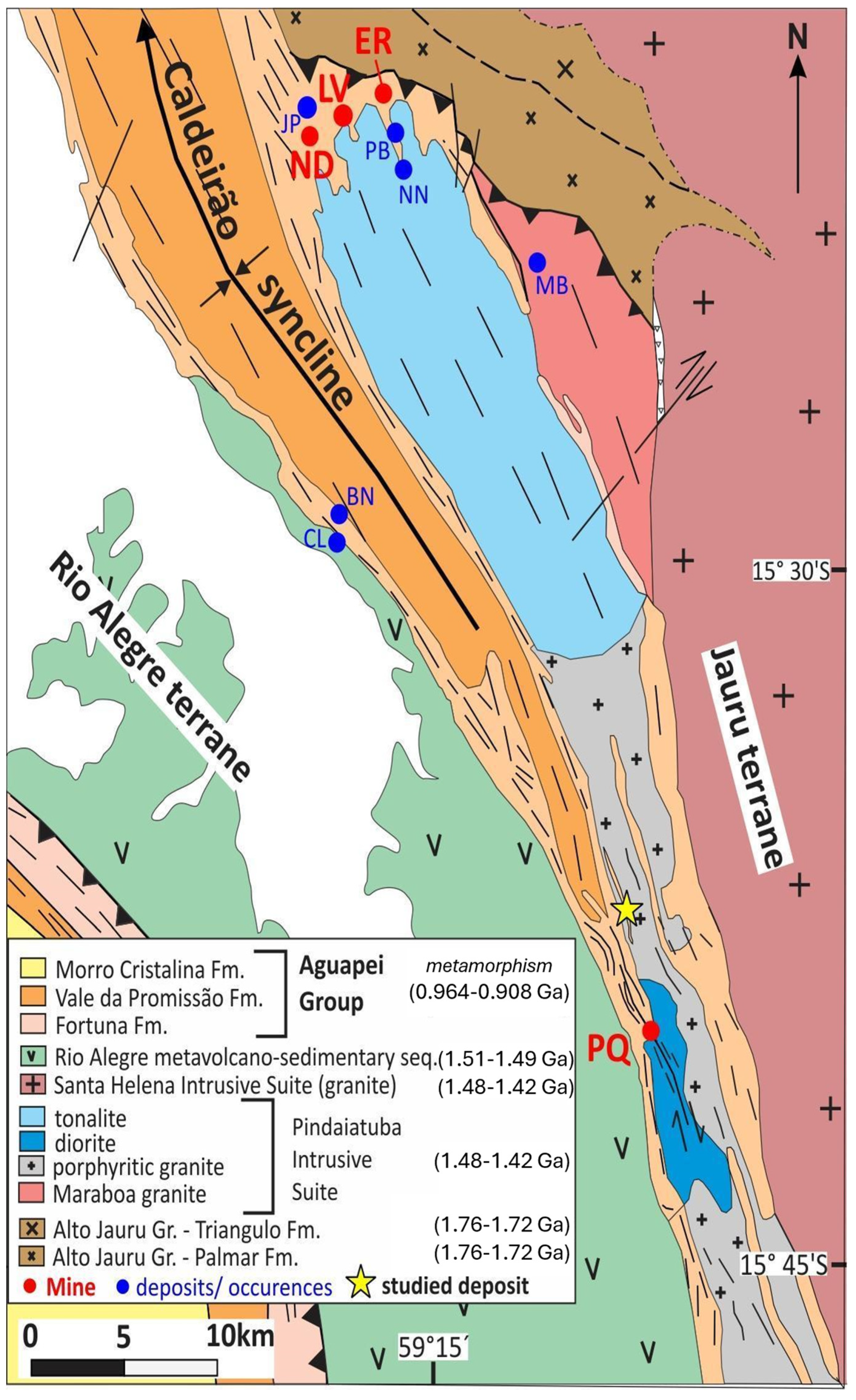
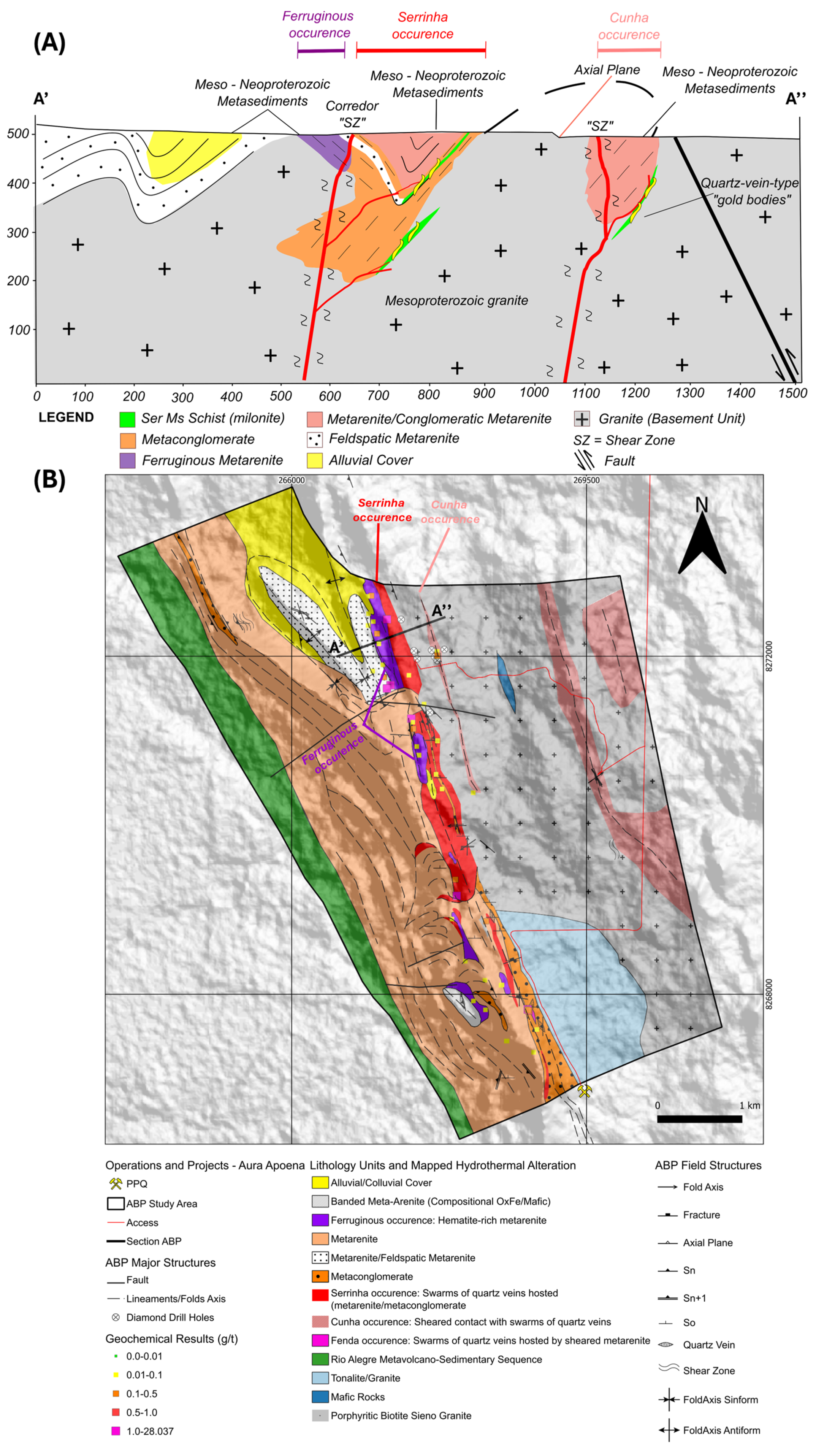
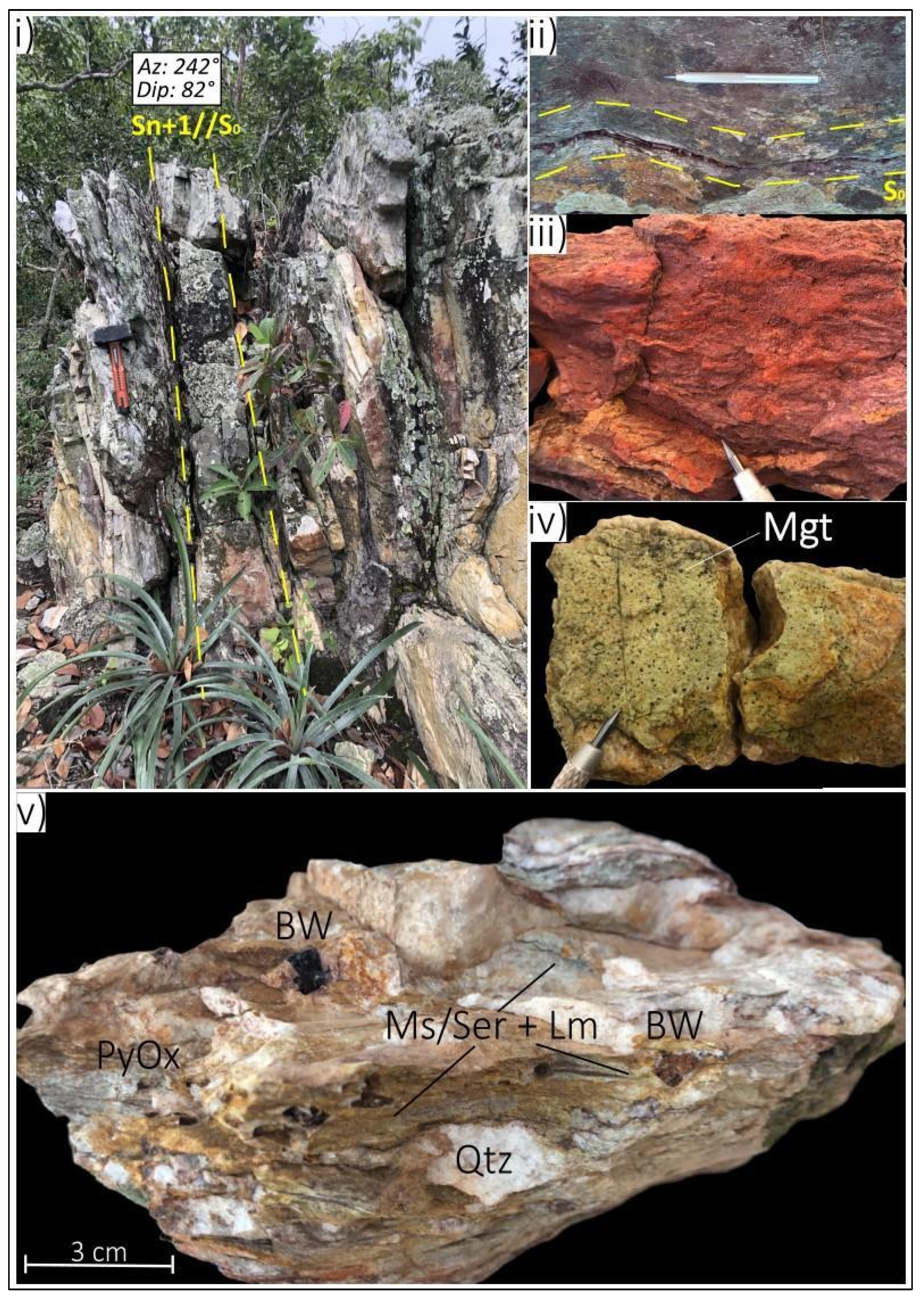
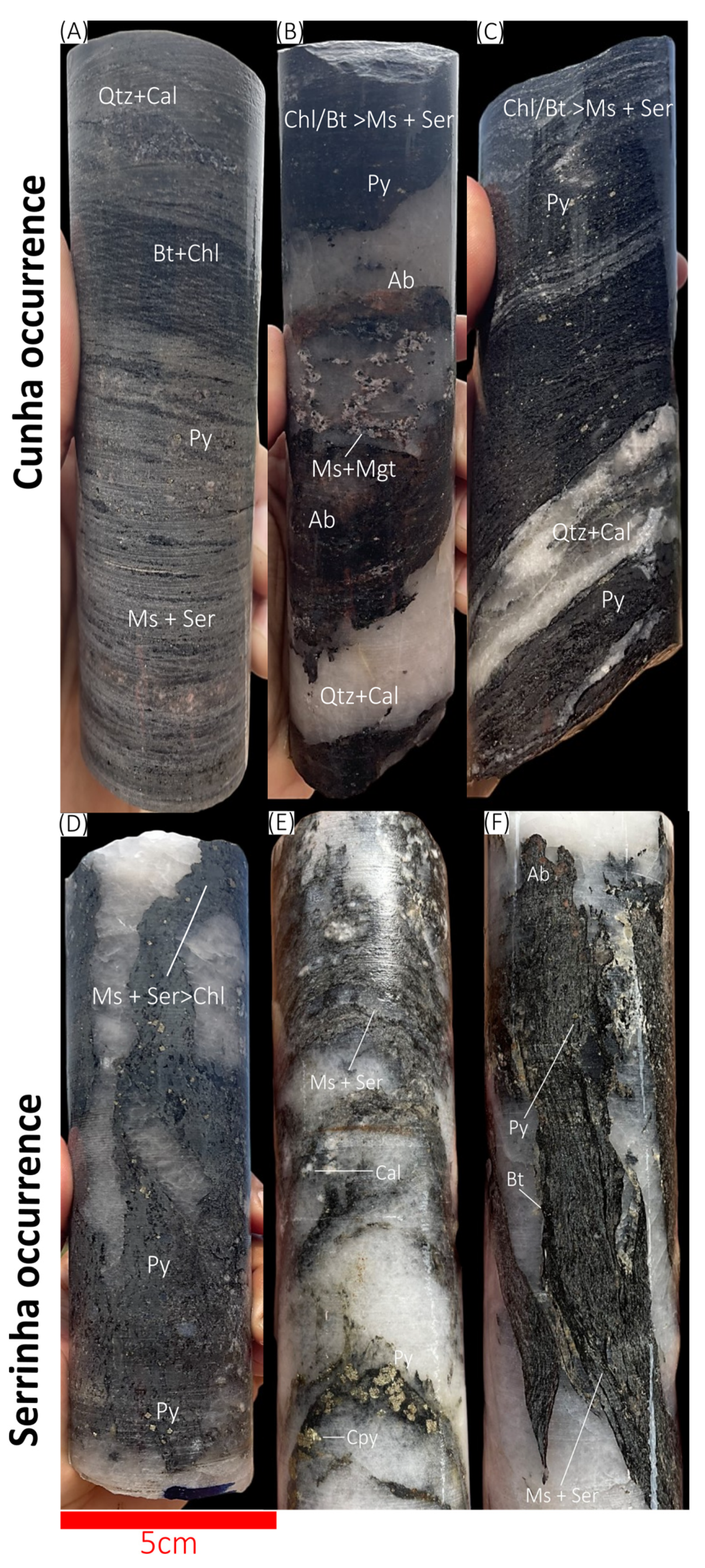
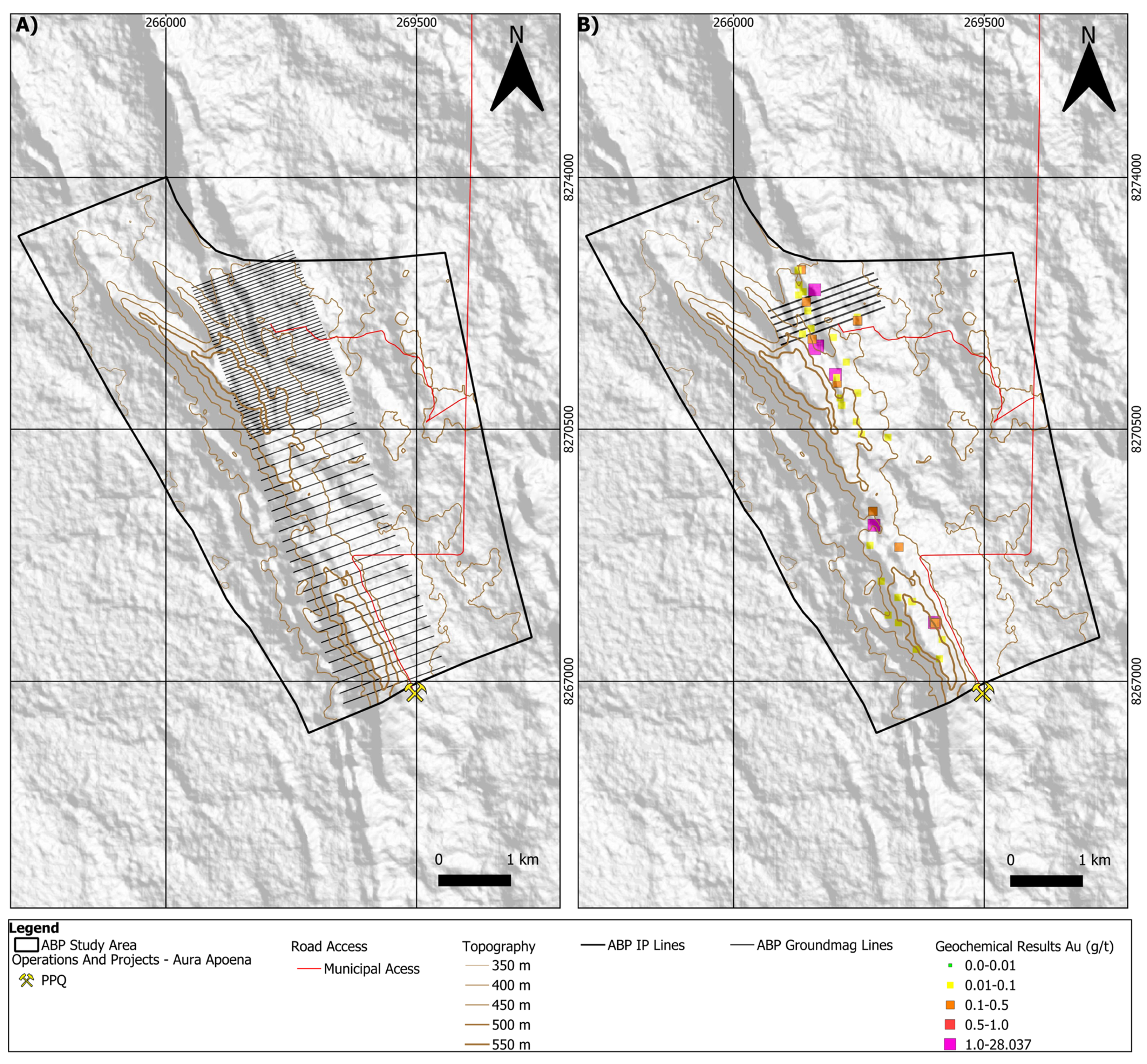
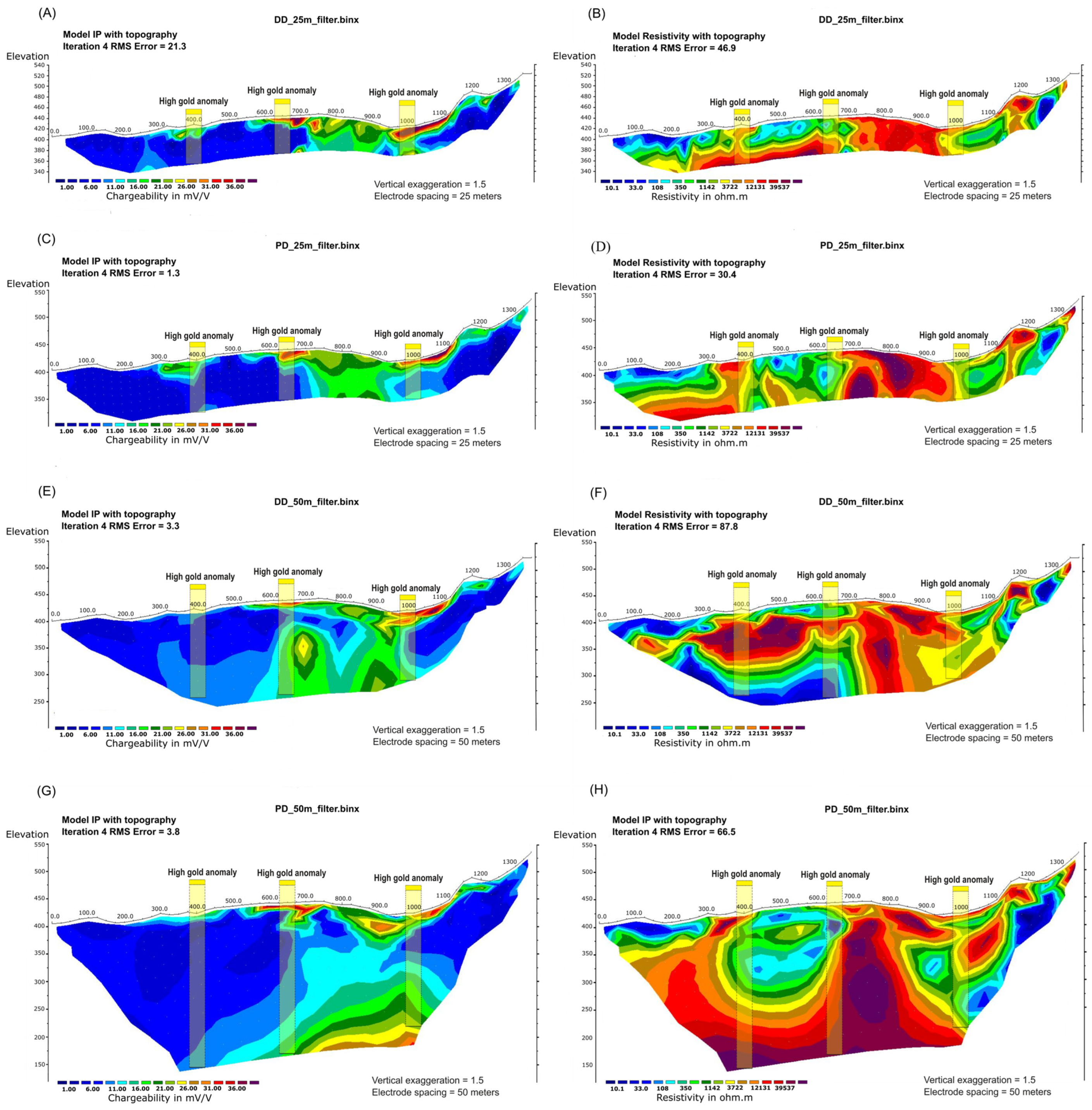
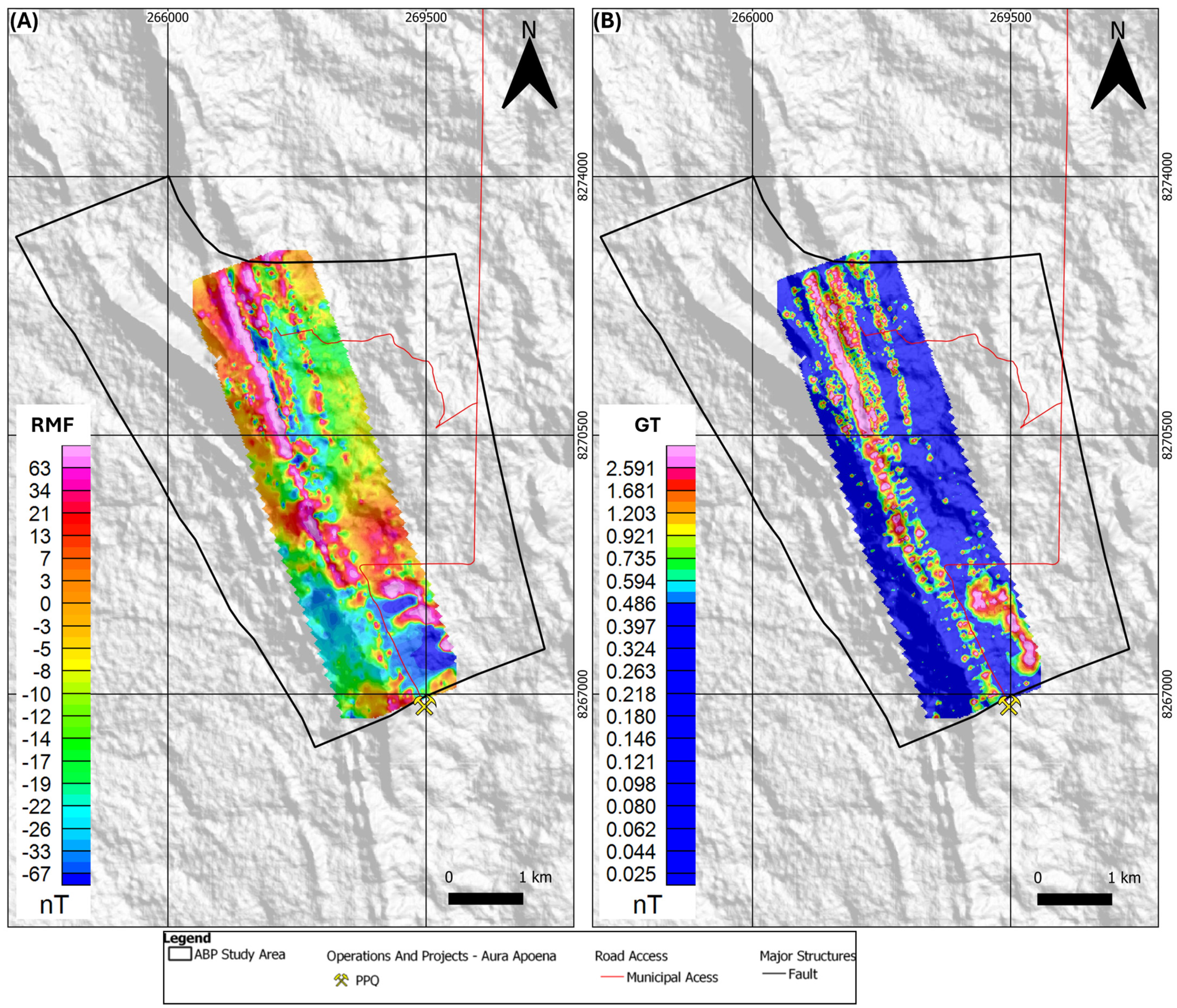
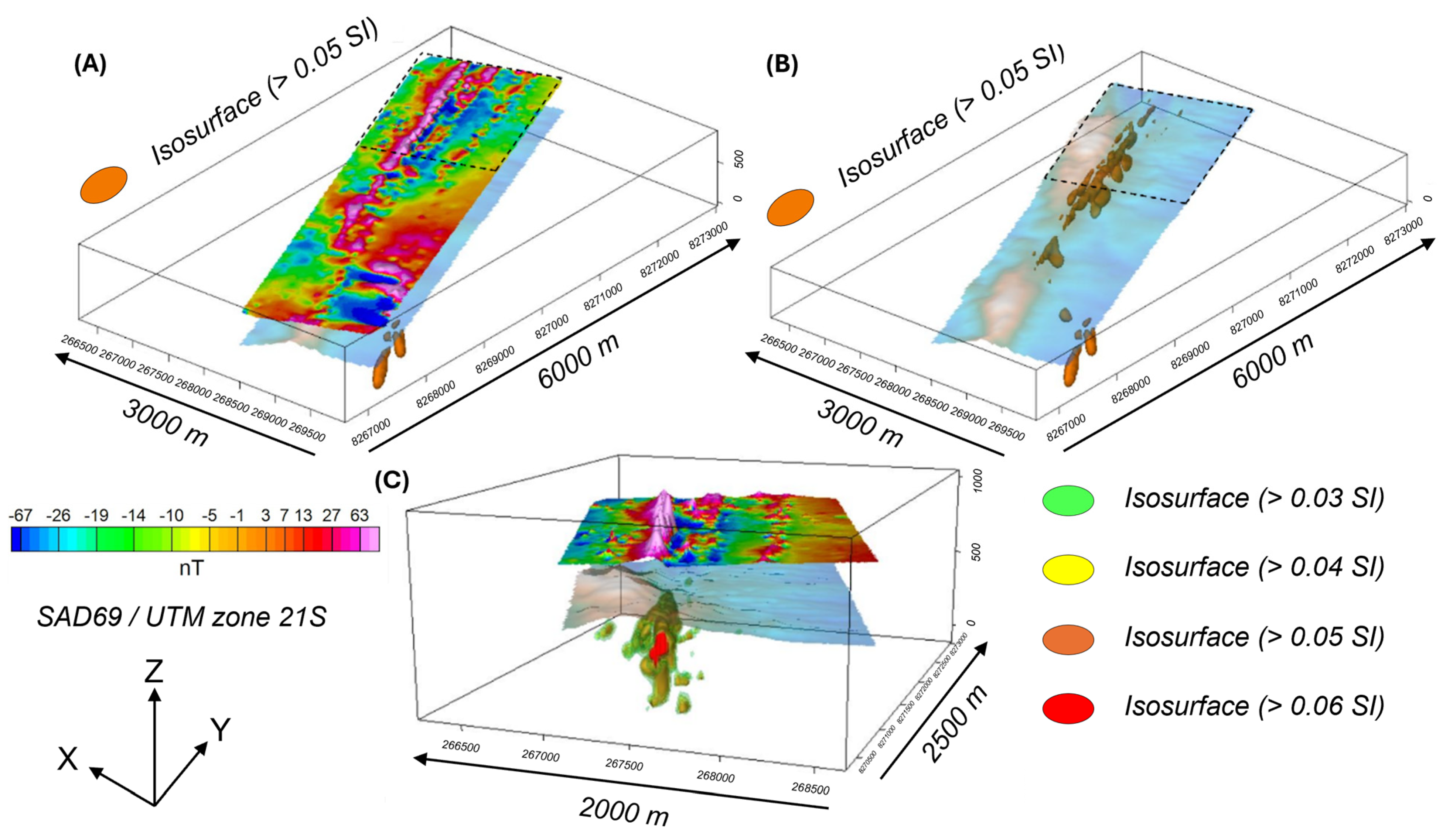
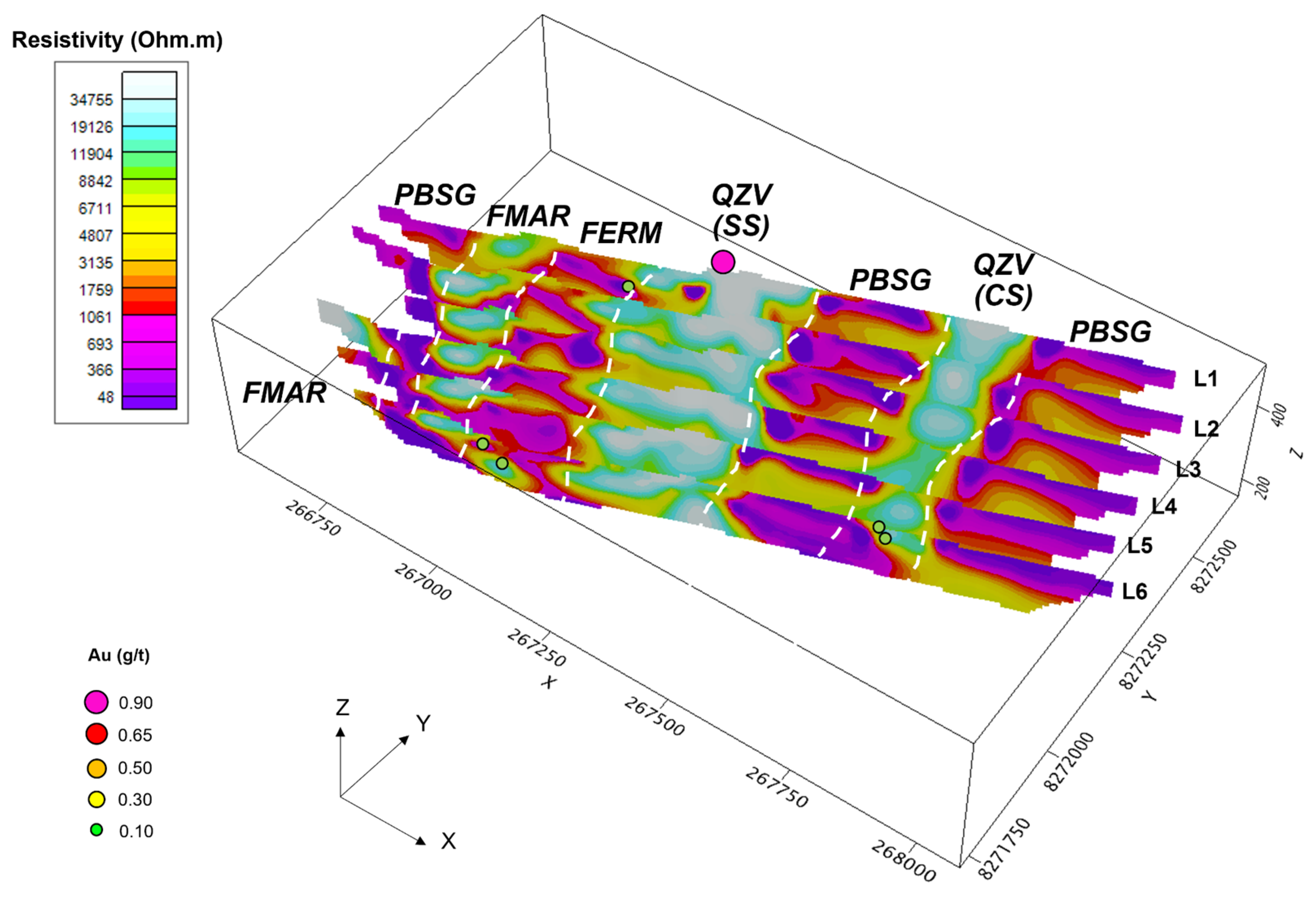
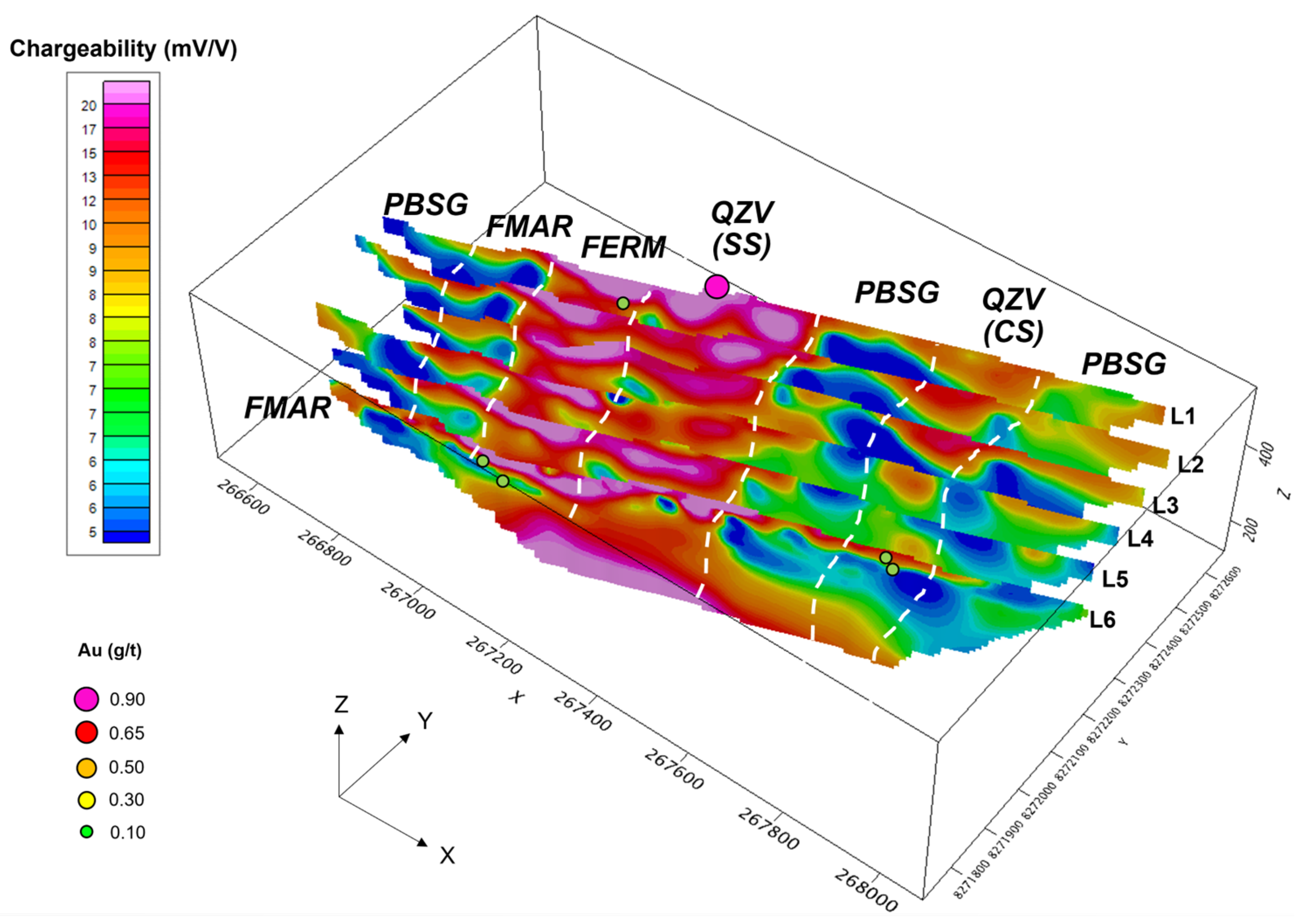
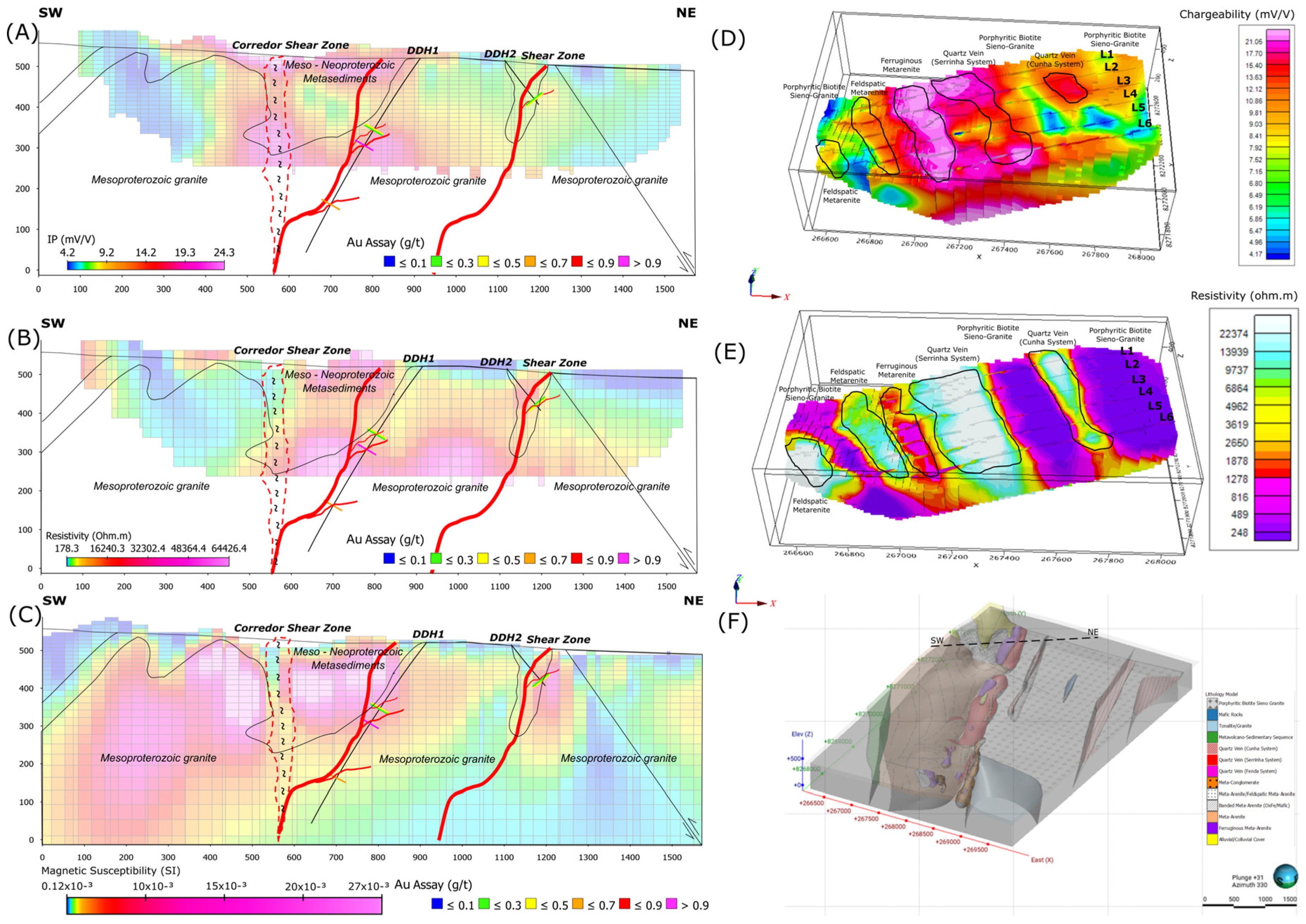
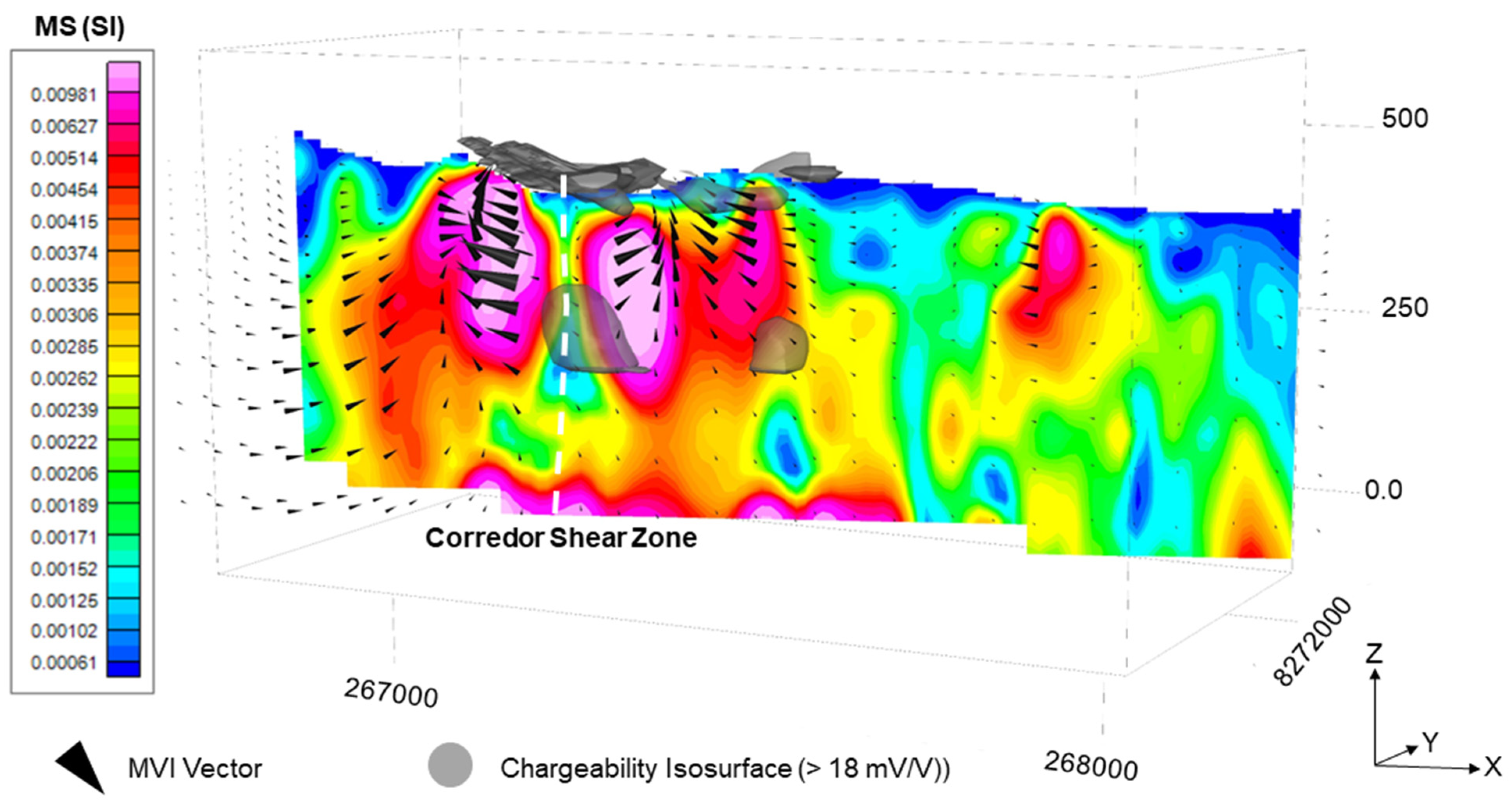
Disclaimer/Publisher’s Note: The statements, opinions and data contained in all publications are solely those of the individual author(s) and contributor(s) and not of MDPI and/or the editor(s). MDPI and/or the editor(s) disclaim responsibility for any injury to people or property resulting from any ideas, methods, instructions or products referred to in the content. |
© 2024 by the authors. Licensee MDPI, Basel, Switzerland. This article is an open access article distributed under the terms and conditions of the Creative Commons Attribution (CC BY) license (https://creativecommons.org/licenses/by/4.0/).
Share and Cite
Echague, J.; Leão-Santos, M.; Melo, R.; Mendes, T.; Borges, W. Application of Geophysical Methods in the Identification of Mineralized Structures and Ranking of Areas for Drilling as Exemplified by Alto Guaporé Orogenic Gold Province. Minerals 2024, 14, 788. https://doi.org/10.3390/min14080788
Echague J, Leão-Santos M, Melo R, Mendes T, Borges W. Application of Geophysical Methods in the Identification of Mineralized Structures and Ranking of Areas for Drilling as Exemplified by Alto Guaporé Orogenic Gold Province. Minerals. 2024; 14(8):788. https://doi.org/10.3390/min14080788
Chicago/Turabian StyleEchague, Jorge, Marcelo Leão-Santos, Rodrigo Melo, Thiago Mendes, and Welitom Borges. 2024. "Application of Geophysical Methods in the Identification of Mineralized Structures and Ranking of Areas for Drilling as Exemplified by Alto Guaporé Orogenic Gold Province" Minerals 14, no. 8: 788. https://doi.org/10.3390/min14080788
APA StyleEchague, J., Leão-Santos, M., Melo, R., Mendes, T., & Borges, W. (2024). Application of Geophysical Methods in the Identification of Mineralized Structures and Ranking of Areas for Drilling as Exemplified by Alto Guaporé Orogenic Gold Province. Minerals, 14(8), 788. https://doi.org/10.3390/min14080788








